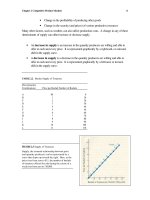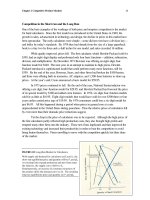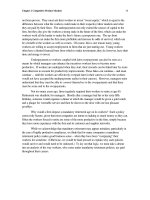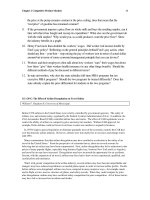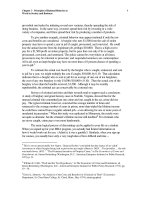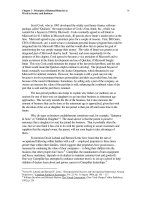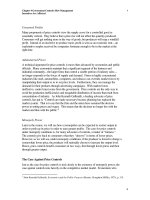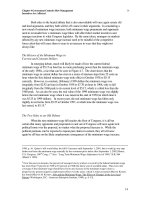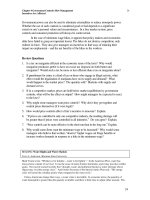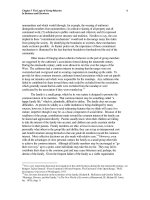Tài liệu Microeconomics for MBAs 19 pptx
Bạn đang xem bản rút gọn của tài liệu. Xem và tải ngay bản đầy đủ của tài liệu tại đây (39.09 KB, 10 trang )
Chapter 5 The Logic of Group Behavior
In Business and Elsewhere
49
But at the level of the tribe or group society has always found itself able to
cohere.
62
With a reasonable degree of clarity both the theory and the evidence suggest that if
society wishes to pursue some interest that is common to people on a very broad scale,
some means other than voluntary group cooperation must be found. It is for this reason
we begin again a study of the markets after we look inside the “firm” to see how the
“logic of group behavior” explains incentives within firms.
Review Questions
1. Explain why the “free-rider” problem is likely to be greater in a “large” group than in
a “small” group.
2. The common interest of people who are in a burning theater is to walk out orderly and
in other ways avoid a panic. If that is the case, why do people so frequently panic in
such situations? Use rational behavior and the logic of collective action in your
answer.
3. Relating to Table5.2, we wrote that Harry is unwilling to eliminate more than Q
1
dandelions and that Fred must bear a portion of the cost of eradicating dandelions if
more than Q
1
dandelions are to be eradicated. Explain these statements in terms of
the graph.
4. Discuss the costs of making collective decisions in large and small groups. What do
these costs have to do with the viability of large and small groups?
5. Intelligent collective decisions can be a common interest shared by members of a
large group. Does the analysis of in this chapter suggest anything about the incentive
that individuals have to obtain information or about the intelligence of decisions that
a large group will make?
6. In what ways do firms overcome the problems discussed in this chapter relating to
large groups? How do market pressures affect firm incentives to overcome these
problems?
7. Would you expect private firms or government bureaucracies to be more efficient in
pursuing the stated “common objectives” of the organization? Explain in terms of the
logic of collective action and market forces.
8. You may have a class in which the professor grades according to a curve, whereby he
adjusts his or her grading scale to fit the test results. This may also be a class in
which everyone in it would prefer not to learn as much as they will. If you are in
such a situation (or can imagine one like it), the “common interest “ of the class
members can be for everyone to study less. The same grading distribution can be
62
George C. Homans, The Human Group (New York: Harcourt, Brace, Inc., 1950), pp. 454-456, as cited
in Olson, Logic of Collective Action, p. 56.
Chapter 5 The Logic of Group Behavior
In Business and Elsewhere
50
obtained, and everyone can receive his same relative grade for less effort. Why do
class members not collude and restrict the amount of studying they do? Would you
expect collusion to not study more likely in undergraduate general education courses,
core classes in your MBA program, or elective classes in your MBA program?
CHAPTER 6
Reasons for Firm Incentives
Amazing things happen when people take responsibility for everything themselves. The
results are quite different, and at times people are unrecognizable. Work changes and
attitudes to it, too.
Mikhail Gorbachev
n conventional economic discussions of how firms are managed, incentives are nowhere
considered. This is the case because the “firm” is little more than a theoretical “black box”
in which things happen somewhat mysteriously. Economists typically acknowledge that the
“firm” is the basic production unit, but little or nothing is said of why the firm ever came into
existence or, for that matter, what the firm is. As a consequence, we are told little about why
firms do what they do (and don’t do). There is nothing in conventional discussions that tells us
about the role of real people in a firm.
How are firms to be distinguished from the markets they inhabit, especially in terms of
the incentives people in firms and markets face? That question is seldom addressed (other than,
perhaps, specifying that firms can be one of several legal forms, for example, proprietorships,
partnerships, professional associations, or corporations). In conventional discussions of the
“theory of the firm,” firms maximize their profits, which is their only noted raison d’être. But
students of conventional theory are never told how firms do what they are supposed to do, or
why they do what they do. The owners, presumably, devise ways to ensure that everyone in
the organization follows instructions, all of which are intent on squeezing every ounce of profit
from every opportunity. Students are never told what the instructions are or what is done to
ensure that workers follow them. The structure of incentives inside the firm never comes up
because their purpose is effectively assumed away: people do what they are supposed to do,
naturally or by some unspecified mysterious process. For people in business, the economist’s
approach to the “firm” must appear strange indeed, given that business people spend much of
their working day trying to coax people to do what they are supposed to do. Nothing is less
automatic in business than getting people to pay attention to their firms’ profits (as distinguished
from the workers’ more personal concerns).
In this chapter, before we delve into the structure of firm costs in following chapters, we
address the issue of why firms exist not because it is an interesting philosophical question.
Rather, we are concerned with that question because its answer can help us understand why the
existence of firms and incentives go hand in hand. There is more than an ounce of truth to the
refrain, “You cannot have one without the other.” In this chapter, we lay out the limited
I
Chapter 6. Reasons for Firm Incentives
2
economic propositions that will undergird the analysis of much of the book. These propositions
are powerful as they are simple, are relatively easily to understand.
How Firms Make Markets More Efficient
Why is it that firms add to the efficiency of the markets? That’s an intriguing question, especially
given how standard theories trumpet the superior efficiency of markets. Students of
conventional theory might rightfully wonder: If markets are so efficient, why do entrepreneurs
ever go to the trouble of organizing firms? Why not just have everything done by way of
markets, with little or nothing actually done (in the sense that things are “made”) inside firms?
All of the firm’s inputs could be bought by individuals, with each individual adding value to the
inputs he or she purchases and then selling this result to another individual who adds more value,
etc. until a final product is produced and a final market is reached at which point the completed
product is sold to consumers. The various independent suppliers may be at the same general
location, even in the same building, but everyone, at all times, could be up for contracting with
all other suppliers or some centralized buyer of the inputs. By keeping everything on a market
basis, the benefits of competition could be constantly reaped. Entrepreneurs could always look
for competitive bids from alternative suppliers for everything used -- whether in the form of
parts to be assembled, accounting and computer services to be used, or, for that matter,
executive talent to be employed.
Individuals, as producers relying exclusively on markets, could always take the least
costly bid. They could also keep their options open, including retaining the option to switch to
new suppliers that propose better deals. No one would be tied down to internal sources of
supply for their production needs. They would not have to incur the considerable costs of
organizing themselves into production teams and departments and various levels of management.
They would not have to incur the costs of internal management. They could, so to speak,
maintain a great deal of freedom!
Then why do firms exist? What is the incentive – driving force – behind firms? For that
matter, what is a firm in the first place? University of Chicago Law and Economics Professor
Ronald Coase, on whose classic work “The Nature of the Firm” much of this chapter is based
and many of the particular arguments drawn, proposed a substantially new but deceptively
simple explanation.
1
He reasoned that the firm is any organization that supercedes the pricing
system, in which hierarchy, and methods of command and control are substituted for exchanges.
To use his exact words: “A firm, therefore, consists of the system of relationships which comes
into existence when the direction of resources is dependent on an entrepreneur.”
2
1
Ronald H. Coase, “The Nature of the Firm,” Economica, vol. 4 (1937), pp. 386-405, reprinted in R. H. Coase,
The Firm, the Market, and the Law (Chicago: University of Chicago Press, 1988), pp. 33-55.
2
Ibid., pp. 41-42.
Chapter 6. Reasons for Firm Incentives
3
Good answers to the question of why firms exist is more complicated and longer in the
making than might be thought, but space limitations of this book require us to be brief. Some
economists have speculated that firms exist because of the economies of specialization of
resources, a key one being labor. Clearly, Adam Smith and many of his followers were correct
when they observed that when tasks are divided among a number of workers, the workers
become more proficient at what they do. Smith began his economic classic The Wealth of
Nations by writing about how specialization of labor increased “pin” (really nail) production.
3
By specializing, workers can become more proficient at what they do, which means they can
produce more in their time at work. They also don’t have to waste time changing tasks, which
means more time can be spent directly on production.
While efficiency improvements can certainly be had from specialization of any resource,
especially labor, Smith was wrong to conclude that firms were necessary to coordinate the
workers’ separate tasks. This is because, as economists have long recognized, their separate
tasks could be coordinated by the pricing system within markets.
Markets could, conceivably, exist even within the stages of production that are held
together by, say, assembly lines. Workers at the various stages could simply buy what is
produced before them. The person who produces soles in a shoe factory could buy the leather
and then sell the completed soles to the shoe assemblers. For example, the bookkeeping
services provided a shoe factory by its accounting department could easily be bought on the
market. Similarly, all of the intermediate goods involved in Smith’s pin production could be
bought and sold until the completed pins are sold to those who want them.
Why, then, do we observe firms as such, which organize activities by hierarchies and
directions that are not based on changing prices (which distinguishes them from markets)? In
terms of our examples, why are there shoe and pin companies? Admittedly, over the years
economists have tendered various answers.
4
3
Adam Smith, An Inquiry into the Nature and Causes of the Wealth of Nations (New York: Modern Library,
1937), pp. 4-12.
4
The late University of Chicago economist Frank Knight speculated that firms arise because of uncertainty
(Risk, Uncertainty, and Profit [Chicago: University of Chicago Press, 1971]). If business were conducted in a
totally certain world, there would be no need for firms, according to Knight. Workers would know their
pattern of rewards, and there would be no need for anyone to specialize in the acceptance of the costs of
dealing with risks and uncertainties that abound in the real world of business.
As it is, according to Knight, some workers are willing to work for firms because of the type of deal
that is struck: The workers accept a reduction in their expected pay in order to reduce the variability and
outright uncertainty of that pay. Entrepreneurs are willing to make such a bargain with their workers
because they are effectively paid to do so by their workers (who accept a reduction in pay) and because the
employers can reduce their exposure to risk and uncertainties faced by individual workers by making similar
bargains with a host of workers. As Knight put it (see the bottom of the next page),
This fact [the intelligence of one person can be used to direct others] is responsible for the
most fundamental change of all in the form of organization, the system under which the
confident and adventuresome assume the risk or insure the doubtful and timid by
